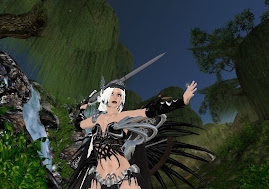





If one is enamoured with the Roman Empire, one can find a very detailed reconstruction of the 'Eternal City' from the period of Caesar Augustus. You can find Roma in a search for Roma (SPQR) to distinguish it from other sims that use the name of the imperial city without any real reference to its identity in any ccentury. As the contemporary world prepares for the Yuletide season, Roma celebrates the old festival of Saturnalia.
All visitors to Roma must enter through the old Customs House after teleporting to a designated landing spot at a wharf. One is not allowed to fly in Roma, increasing a sense of a real journey to the past. One can walk or hire a litter.
The real governor of the Roma sim is Torin Golding. He is extremely active in the daily life of Roma as well as having been involved in every stage of its creation.
Details of Roman history are included at every point. At each fountain, you can 'summon' the deity who presides there, to gain information about the neighbourhood through which you pass. Neptune himself presides over the Harbour District, and will invite you to take a free boat ride, ending his speech with the mandatory 'Hail Caesar!'
The Hippodrome at the Circus Maximus offers visitors an opportunity to drive a chariot either for practice or in a real chariot race. I took advantage of the opportunity but failed miserably to control my horses properly and the sight no doubt would have disgusted any true Roman. Fortunately, the viewing stands were empty.
Last night's Saturnalia celebrations included word games, knive throwing, mud wrestling, arm-wrestling and a competition to climb a 'Tower of Doom'. I won a bottle or glass of wine by unscrambling a word. All words had Latin roots. The sim does maintain a good policy of using the 'dead' language routinely.
It is interesting to see how use of Latin has been revived by the media in films such as Mel Gibson's 'Passion of the Christ' and the series 'Roma'. It is an elegant language and deserves far more attention academically.
The popularity of the Roma SPQR sim is encouraging as well. There appear to be quite a large number of individuals who are interested in participating in a sim where Latin is considered to be the 'lingua franca'.
The photographs I have posted here show various locations in Roma, including the Customs House, the Market at the harbour area and shopping precinct. The Circus Maximus can be seen on the right side of the long stairway.
The Saturnalia was one of the most important and popular festivals in Roman civilisation. It was devoted to the god Saturn, lord of the Earth, especially in its underworld aspects. As such, he guarded the seed that lay dormant through the winter months until the season of new growth in the Spring.
As with most 'year-end' festivals in the ancient world, the Saturnalia involved a 'Lord of Misrule' and a temporary transposition of power from master to slave. This sort of practice is characteristic of cultures that are dominated by seasonal changes. In Roma during the Saturnalia, masters would serve their slaves. All licence was permitted and punishments were suspended. Originally a festival that occurred on 17 December, the Saturnalia later was celebrated for an entire week. The emperor Augustus reduced the festival duration to three days but later, the longer period of celebration was restored.
Saturn was identified with Kronos and sacrifices were made according to Greek custom with the head uncovered. Dedication of the oldest temple recorded by the pontiffs, the Temple of Saturn had been made during the Saturnalia. On that day, the woolen bonds that fettered the feet of the ivory cult statue of Saturn within the temple were loosened to symbolise the liberation of the god.
Essentially, the season of Saturnalia was given to devotion to three gods: Saturn and his wife, Ops and the god Consus. Ops was the Goddess of Plenty and Consus was the guardian of hidden treasures. He therefore took charge of the seed grain and was the keeper of all 'hoards'. Winter is the season when food and supplies must be hoarded in anticipation of the dark months until Spring. The purpose of Saturnalia was to persuade the gods to aid the people in survival through the winter months.
Saturnalia, like Christmas, was a gift-giving festival and a time when great feasts were held. Typical gifts for Saturnalia were cerei and sigillaria. Cerei were beeswax candles. Sigillaria were small figurines made of earthenware. These items are of great antiquity, predating Roman civilisation. The custom of binding and unbinding of the god also is far more ancient than Saturnalia.
Lucian decribes the festival purportedly in the god's own words as follows: 'During My week the serious is barred; no business allowed. Drinking, noise and games and dice, appointing of kings and feasting of slaves, singing naked, clapping of frenzied hands, an occasional ducking of corked faces in icy water— such are the functions over which I preside.'
Incidentally, the evergreen tree erected in the Temple of Saturn in Roma actually is associated not with the god Saturn but with Attis. Nonetheless, the Romans were extremely eclectic in their religion, eagerly embraced foreign practices and traditions as they made Roma the centre of the 'known world'.





